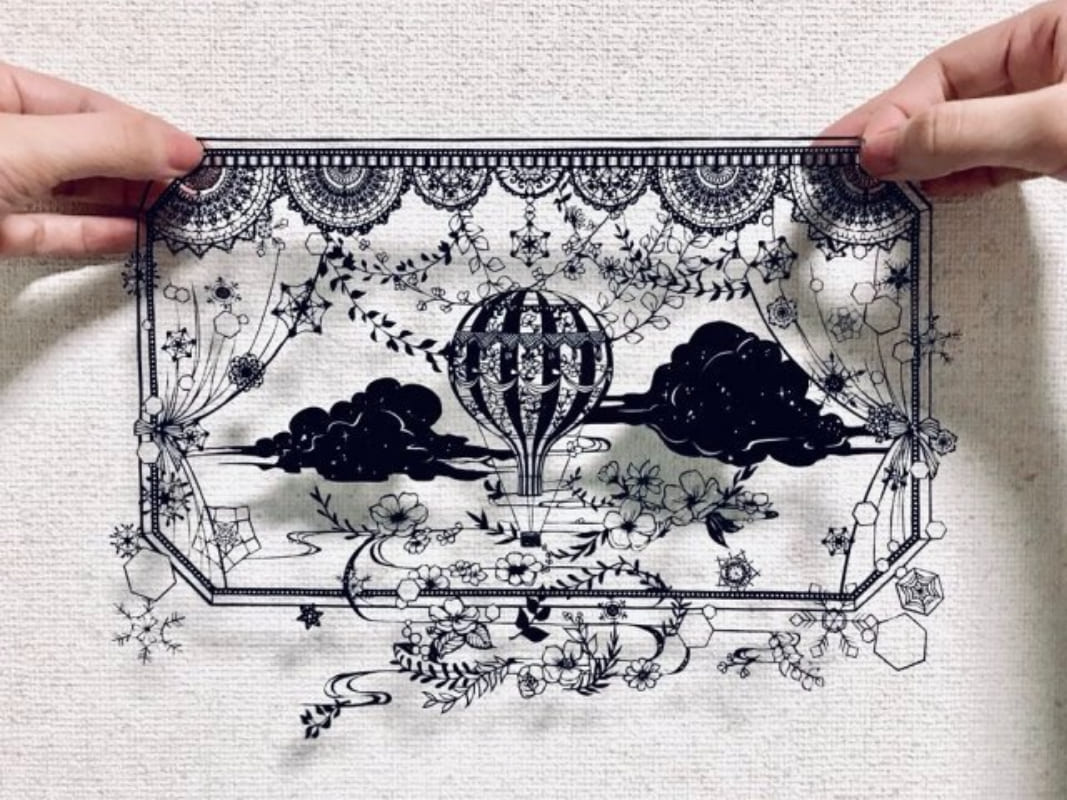
Blog
Kirigami History: Timeless Art of Cutting and Folding Paper

Delving into the kirigami history introduces us to a captivating Japanese art form that blends the techniques of cutting and folding paper to craft intricate and stunning designs. Originating from the combination of the Japanese words ‘kiru‘ (to cut) and ‘kami‘ (paper), kirigami history has a storied past rich with cultural significance. This artistic practice, celebrated across the globe, has been passed down through generations, showcasing a legacy of creativity and innovation.
Kirigami History Development: From Ancient Rituals to Global Artistry

The kirigami history stretches back to Japan’s Heian period, from the 8th to the 12th century, marking the beginnings of this revered art form. In those times, paper was more than just a medium for art; it was a precious and rare resource, often utilized in religious ceremonies. Seen as a sacred bridge between the physical and spiritual realms, paper’s use in kirigami during this era highlights the deep-rooted spiritual connections and cultural values embedded in the art form. Kirigami’s evolution from these ancient practices to its current global appreciation is a testament to its enduring beauty and significance.
Expanding on the rituals and ceremonies, kirigami was traditionally used in Shinto rituals to create ‘shide’, zigzag-shaped paper streamers, symbolizing purity and the presence of divine spirits. These practices highlight kirigami’s role in purifying and protecting sacred spaces, reflecting its deep spiritual significance. The paper used in ancient times was ‘washi’, a durable and flexible paper made from mulberry bark, which contributed to the art’s distinctive texture and form. Understanding these materials provides insight into kirigami’s unique aesthetic and its adaptation over centuries.
Digging deeper into kirigami history, one of the earliest and most fascinating examples is a paper screen crafted in the 10th century by monk Seiwa Genjo. This masterpiece showcased complex cut-out patterns, designed to represent the unity of all life. The tradition of kirigami also includes making paper dolls, cherished gifts for children, and creating paper flowers, integral to religious celebrations and festivals. These early forms of kirigami not only highlight the art’s aesthetic beauty but also its role in expressing important cultural and spiritual themes.

As we journey further into kirigami history, the Edo period (1603-1868) marks a significant era of expansion and innovation for this art form. With paper becoming more accessible and affordable, kirigami flourished across Japan. Artists explored new horizons, crafting everything from lanterns and fans to ornate decorative boxes. This era set the stage for kirigami history evolution, with its popularity soaring into the 19th and 20th centuries. During these times, artists and designers continued to push the boundaries of kirigami, introducing novel techniques and styles that enriched its tradition and secured its place in both historical and modern creative expression.
In the Edo period, as kirigami gained popularity among the general populace, it began reflecting themes of daily life and natural beauty, diverging from its strictly religious origins. Notable artists like Toba Hiromi emerged, specializing in creating elaborate scenes of Japanese folklore and daily activities. The introduction of colored paper in this era added a new dimension to kirigami, allowing for more expressive and vibrant artworks. The Meiji Restoration and subsequent globalization introduced Japan to Western paper-making techniques, further enriching the kirigami tradition with new textures and colors, thus setting the stage for its modern diversity.
Today, kirigami history continues to unfold worldwide, embraced by varied cultures and inspiring artists beyond its Japanese origins. Modern kirigami ranges from traditional designs to novel creations like intricate geometric figures and playful depictions of nature. This art form’s enduring appeal lies in its versatility and the creative bridge it forms between past and present, celebrating a global community of artists and enthusiasts
Innovations in Art, Science, and Design from Modern Kirigami History

Kirigami holds deep cultural and artistic importance. In Japan, it’s a key part of many religious celebrations and festivals, and it plays a role in traditional architecture and design. Kirigami is also at the heart of classic Japanese toys and games, like paper cranes and fortune tellers, reflecting its integral place in Japanese heritage.
Beyond its cultural roots, kirigami has found applications in science and engineering, where designs inspired by kirigami make materials and structures more flexible. This includes innovations like bendable solar panels and medical implants. Researchers even use kirigami principles to explore how materials behave at an incredibly small scale.
The application of kirigami in scientific fields has led to breakthroughs such as the development of stretchable electronics. By applying kirigami cuts to materials like graphene, scientists have created flexible electronic devices that can expand and contract without breaking, paving the way for innovations in wearable technology. In the medical field, kirigami-inspired stents and implants have been designed to adapt dynamically with the body’s movements, offering new solutions for complex medical challenges.
In the arts and design world, kirigami continues to inspire. Contemporary artists and designers often use kirigami techniques to create complex and captivating pieces, extending the possibilities of paper art. Kirigami’s influence is visible in fashion, architecture, and product design, showcasing its versatility and enduring appeal in creative industries.

In the realm of contemporary art, artists like Sipho Mabona have pushed the boundaries of kirigami, creating life-sized animal sculptures that challenge our perception of paper as a simple material. These artists’ work not only showcases the technical mastery of kirigami but also explores themes of environmentalism and the transient nature of life, demonstrating how traditional arts can convey powerful messages about modern issues.
Cultural and Spiritual Symbolism in Kirigami
Kirigami is deeply intertwined with Japanese culture and spirituality, offering a unique window into the values and beliefs of its people. Each kirigami design carries symbolic meaning, often derived from nature and spirituality. For example, the crane, a popular motif in kirigami, symbolizes longevity and good fortune, while cherry blossoms represent the fleeting beauty of life. These symbols are not only artistic expressions but also convey messages of hope, resilience, and connection to nature.
The art of kirigami extends beyond decoration and entertainment, playing a vital role in religious and spiritual ceremonies. In Shintoism, kirigami is used to create intricate paper offerings and decorations for altars, believed to bridge the physical and spiritual worlds. These practices underscore kirigami’s sacred role in connecting humans with the divine, reflecting a harmonious balance between art, nature, and spirituality.
Kirigami in Education and Therapy
Kirigami offers significant benefits in educational settings, serving as a powerful tool for learning and development. Engaging with kirigami helps students enhance their fine motor skills, spatial awareness, and concentration. Teachers often incorporate kirigami into lessons on geometry, art, and cultural studies, allowing students to experience hands-on learning that bridges theoretical knowledge with creative expression.
Moreover, kirigami has therapeutic value, aiding in stress relief and mental well-being. The focused, meditative process of cutting and folding paper allows individuals to engage in mindfulness practices, reducing anxiety and promoting a sense of calm. Art therapists utilize kirigami to help clients express emotions, improve cognitive functions, and develop coping mechanisms, demonstrating the art’s healing potential beyond its aesthetic appeal.
Kirigami Technique and Craftsmanship
To truly appreciate kirigami, one must understand the basics of its technique and craftsmanship. Kirigami history begins with a single piece of paper and involves a series of folds and cuts to create intricate designs. Essential tools for kirigami include sharp scissors or a precision knife, a cutting mat, and high-quality paper that can withstand folding and cutting without tearing.
For beginners, simple projects like snowflakes or symmetrical patterns offer a gentle introduction to kirigami. As skills develop, enthusiasts can attempt more complex designs, such as architectural structures or detailed floral arrangements. Mastery of kirigami requires patience, precision, and an understanding of geometric principles, highlighting the art’s blend of technical skill and creative vision.
Global Influence and Collaborations
Kirigami has transcended its origins to become a global art form, embraced by artists and hobbyists around the world. International exhibitions and workshops have fostered a community of kirigami enthusiasts, sharing techniques and inspiration across cultures. Collaborations between Japanese kirigami masters and artists from other disciplines have led to innovative projects, merging traditional kirigami with modern technologies and materials.
This global exchange has not only expanded the possibilities of kirigami but also highlighted its universal appeal. From intricate paper sculptures displayed in art galleries to kirigami-inspired designs in fashion and architecture, the art form continues to evolve, inspiring new generations to explore its endless potential.
Future Trends and Innovations in Kirigami
Looking ahead, kirigami is poised to influence future trends in art, design, and technology. As environmental sustainability becomes a global priority, kirigami artists are exploring the use of recycled and eco-friendly materials, contributing to a more sustainable practice of art. Advances in digital fabrication technologies, such as laser cutting and 3D printing, are also opening new avenues for kirigami, allowing for more complex and precise designs.
In science and engineering, the principles of kirigami are inspiring innovations in flexible electronics, wearable devices, and adaptable architectural solutions. As researchers and designers continue to explore the applications of kirigami, we can expect to see further integration of this traditional art form into cutting-edge technologies, demonstrating its relevance and adaptability in the modern world.
Kirigami, with its deep roots and engaging history, stands out as a captivating art form. Originating in Japan, it has journeyed to global recognition, enchanting artists, designers, and fans everywhere. The art’s intricate designs fuel creative minds, pushing the boundaries of innovation. From its spiritual roots in ancient Japan to its contemporary role in art, education, and technology, kirigami continues to captivate and inspire, bridging the past with the future and the tangible with the transcendent.
Embrace the World of Handmade Artistry
Are you captivated by the intricate folds and cuts of kirigami? Fascinated by the stories behind each delicate creation? Our journey through the art of kirigami is just the beginning. Join us as we explore the rich tapestry of handmade artistry from around the globe. From the traditional to the contemporary, each story is a testament to human creativity and the enduring appeal of crafting with our hands.
Don’t miss out on our collection of fascinating stories, tutorials, and insights into the world of handmade art. Follow our Blog and immerse yourself in the creativity, inspiration, and passion that fuel these timeless practices. Whether you’re a seasoned artist or a curious newcomer, there’s always something new to discover.
Follow Our Blog for More Interesting Handmade Stories
Instagram | Facebook | TikTok | Pinterest
Become part of our community of artists, crafters, and enthusiasts. Together, let’s celebrate the beauty and diversity of handmade art. See you there!





 Christmas
Christmas Father’s Day
Father’s Day Valentine’s Day
Valentine’s Day Easter
Easter Thanksgiving
Thanksgiving Halloween
Halloween
 Birthday
Birthday Wedding
Wedding Anniversary
Anniversary Graduation
Graduation Baby Shower
Baby Shower House Warming
House Warming
 For Him
For Him For Her
For Her For Kids
For Kids
 Floral
Floral Animals
Animals Trees
Trees Architecture
Architecture Vehicle
Vehicle LGBTQ+
LGBTQ+ Just Because
Just Because
 Pop-up Box
Pop-up Box Pop-up Stand
Pop-up Stand